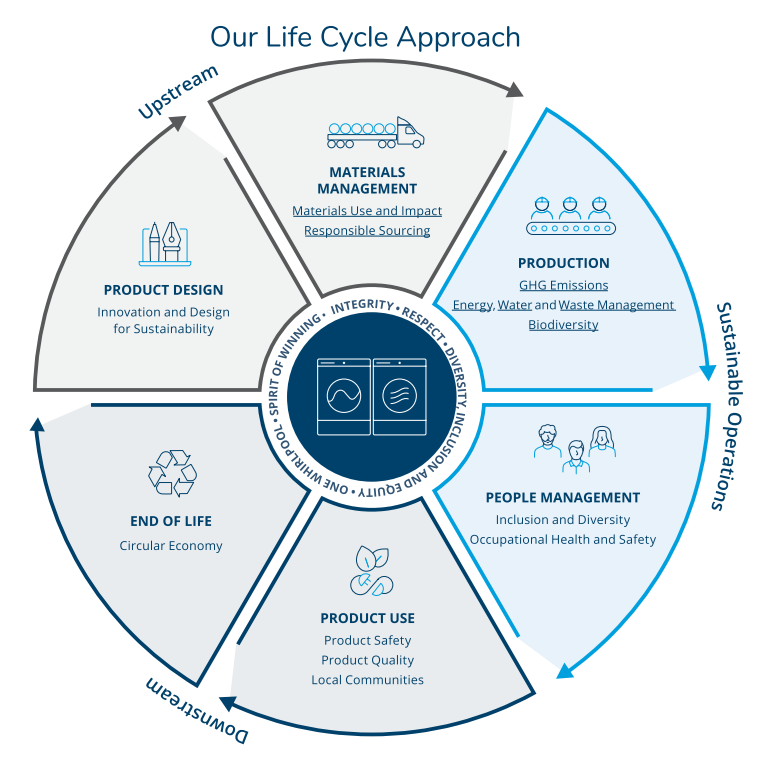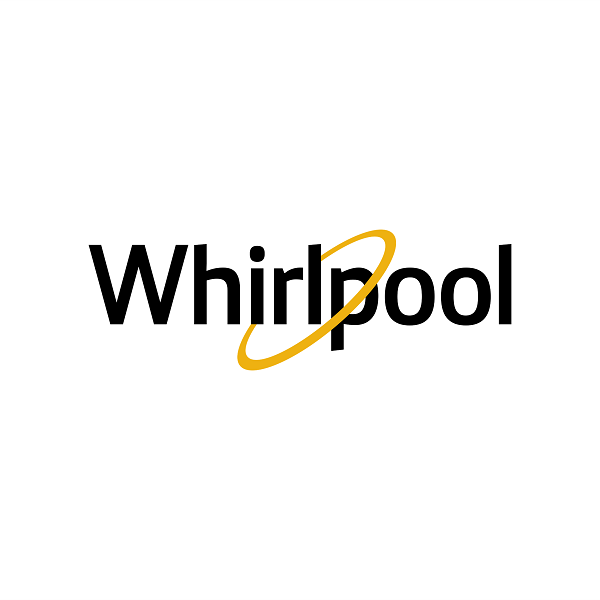Introduction
Founded in 1911, Whirlpool Corporation is a multinational manufacturer and marketer of home appliances.
It has been committed to improving life at home through innovation, community support, and environmental sustainability for over a century.
Be the best global kitchen and laundry company, in constant pursuit of improving life at home.
Important for Us
Whirlpool achieved a 45% reduction in greenhouse gas emissions from 2016 to 2022 and has a dedicated website, Improving Life at Home, that provides content from its brands to help families improve life at home.
It has also been recognized for its commitment to diversity and inclusion.
Criteria
Carbon Footprint, High
Whirlpool is committed to reducing its carbon footprint and has set a goal of achieving net zero emissions from its plants and operations by 2030.
The company has made significant progress in reducing greenhouse gas emissions, achieving a 45% reduction from 2016 to 2022. It has also been recognised by the US Department of Energy for its commitment to reduce greenhouse gas emissions across the portfolio by at least 50% in 10 years.
Whirlpool’s commitment to sustainability is embedded in its business practices, from developing energy efficient appliances to reducing its carbon footprint across its global operations.
Ecological Impact, High
At the manufacturing level, Whirlpool achieved a 25% reduction in total GHGs compared to 2021. They also defined global and regional roadmaps to reach Net Zero by 2030, and activated two large-scale off-site renewable energy projects that, when fully operational, are expected to produce renewable energy to cover 100% of their US plants’ electricity consumption.
Finally, they financed and implemented projects that will produce approximately 18,000 Mt CO2 in GHG reductions.
At the product level, fully integrate sustainability requirements into the product design process by 2023. Reduce in-use product emissions by 20% by 2030 compared to 2016.

Energy Consumption, High
Whirlpool Corporation’s total global energy consumption in 2022 was approximately 5.9 million gigajoules -GJ-, a significant decrease compared to the previous year of 7.4 million GJ.
This reduction was influenced by projects driven by World Class Manufacturing, as well as reduced production volumes. Whirlpool’s energy management and reduction projects in different regions include the installation of solar plants in India, the transition to electric forklifts in Brazil and the opening of a Net Zero-ready plant in Argentina.
Whirlpool is also committed to investing in renewable energy sources and achieving Net Zero emissions in its plants and operations by 2030.
Freight Density, No Information
We couldn’t find reliable information about this topic.
Recycling Rates, High
The company has also moved towards a more circular business model by mitigating the environmental impact of its products with a life-cycle approach.
In 2020, Whirlpool partnered with the World Business Council for Sustainable Development -WBCSD- and other member companies to jointly develop a universal and consistent framework for measuring circularity. The Circular Transition Indicators -CTI- tool was developed to help companies in different industries around the world measure and improve their circular performance.
Whirlpool has launched several initiatives to reduce waste and increase recycling rates. The company offers repair services to keep products working properly, thereby increasing the longevity of its products.
It also has six take-back centres in the US, one in the UK and one in Canada. These centres collect the products, give them a rating, which determines whether they need to be refurbished or used for parts, and then resell the devices that are functional. In 2020, the US take-back centres processed about 205,000 appliances, and more than 104,000 were reconditioned and resold 1.
Whirlpool is also using recycled materials and packaging alternatives to lower product costs and reduce the environmental impact of its products. The company’s Global Materials Compliance Portal enables it to proactively manage substances of concern throughout its complex supply chain.
Saving Levels, High
Whirlpool’s environmental impact results since 2014, globally, can be summarised as follows:
- 21% reduction in energy consumption
- Water consumption reduced by 33%
- CO² emissions decreased by 18%
- Waste produced decreased by 32%
Whirlpool’s commitment to sustainability is embedded in its business practices, from developing energy efficient appliances to reducing its carbon footprint across its global operations.
Specific Product Monitoring, High
In 2022, it redoubled its efforts to design products that make the best use of materials, have an increasingly long lifespan and can be managed responsibly at the end of their useful life.
While the challenges facing our planet are significant, they believe that through innovation and a mindset of continuous improvement, they can make a difference.
Supply Chain Waste, Medium
Whirlpool achievements:
- Achievement of ZWtL gold level -a diversion rate above 95%- at 100% of their large manufacturing sites, in line with UL ECVP 2799 ZWtL, thus avoiding the disposal of more than 20,000 tonnes of waste to landfill in the last five years.
- Reduction of approximately 23% of total waste generated and approximately 48% of hazardous waste generated compared to 2021 data.
- Completed UL training and pre-assessment of three manufacturing sites: Joinville -Latin America-, Clyde -North America- and Cassinetta -EMEA-.
- Defined a new global waste management procedure to be implemented at all manufacturing sites from 2023.
Sustainability Scorecards, High
Whirlpool has published an Environmental, Social and Governance -ESG- Scorecard in its 2021 Annual Report. The scorecard provides a comprehensive view of the company’s progress towards achieving its sustainability goals.
Whirlpool’s ESG scorecard is divided into three categories: Environmental, Social and Governance.
Category Key Metrics:
- Environmental: GHG emissions in plants -metric tons CO2eq in thousands-, GHG emissions in products -metric tons CO2eq in millions-, Gold or Platinum Zero Waste to Landfill -ZWtL- at all manufacturing sites, reduction of hazardous waste generation intensity by 1% year-on-year -YOY- from 2023.
- Social: Job security. Global female representation, local communities
- Governance: Diversity on the Board -independent directors-, responsible sourcing
Water Management, Medium
In 2021, we formalised its commitment to protect employees, help protect the environment, act sustainably and engage all employees as a shared responsibility with the launch of the We Care Standards Manual.
By 2022, they have worked to establish global procedures for their key topics of concern, including water management.
Their total volume of water consumption decreased by 19% compared to 2021. This reduction was influenced by WCM-driven projects as well as reduced production volumes.
Conclusions
The Whirlpool Corp. scored 8/10 in the criteria analysed, making them a sustainable appliances producer with a detailed sustainable roadmap to follow in the coming years.
Read Whirlpool 2022 Sustainability Report.
Related to other brands
Number of criteria met by each brand:
- Electrolux 6.5/10
- Krups-Rowenta 5.5/10
- Siemens-Bosch 9/10





0 Comments